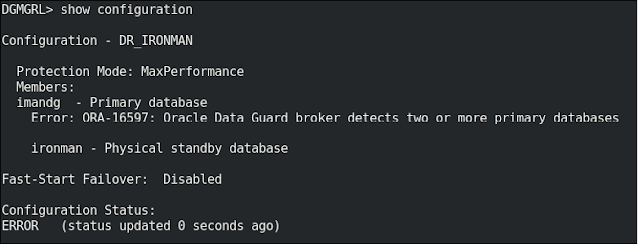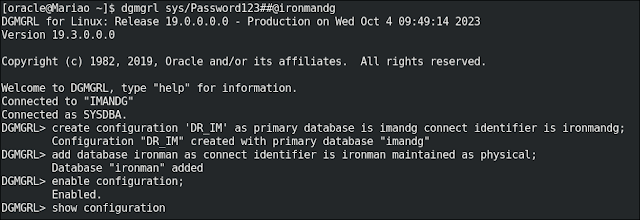- This step-by-step worked for me, but it may not work for you.
- It's a test environment. The real life will be different, for sure.
- This post is for study and testing as well and has no concern for performance and security best practices.
sexta-feira, 8 de março de 2024
[ORACLE] Batch change EDITIONABLE property.
terça-feira, 10 de outubro de 2023
[ORACLE] ORA-16597: Oracle Data Guard Broker detects two or more primary databases. #JoelKallmanDay
Last week, I was doing a test using Data Guard Broker and at the end of the switchover I got the error bellow:
<error barrier> at 0x7ffcb2af9bf0 placed krsl.c@6774
ORA-03135: connection lost contact
*** 2023-10-04 09:57:23.145275 [krsh.c:6348]
- This step-by-step worked for me, but it may not work for you.
- It's a basic and limited environment. The real life will be different, for sure.
- This post is for study and testing as well, and has no concern for performance and security best practices.
rm -f /u01/app/oracle/product/19.3.0.0/db_1/dbs/dr2IMANDG.dat
Protection Mode: MaxPerformance
Members:
imandg - Primary database
ironman - Physical standby database
Properties:
FastStartFailoverThreshold = '30'
OperationTimeout = '30'
TraceLevel = 'USER'
FastStartFailoverLagLimit = '30'
CommunicationTimeout = '180'
ObserverReconnect = '0'
FastStartFailoverAutoReinstate = 'TRUE'
FastStartFailoverPmyShutdown = 'TRUE'
BystandersFollowRoleChange = 'ALL'
ObserverOverride = 'FALSE'
ExternalDestination1 = ''
ExternalDestination2 = ''
PrimaryLostWriteAction = 'CONTINUE'
ConfigurationWideServiceName = 'ironman_CFG'
quinta-feira, 31 de agosto de 2023
[ORACLE] How to configure disks for ASM using UDEV file?
But always remember:
- This step-by-step worked for me, but it may not work for you.
- It's a basic and limited environment. The real life will be different, for sure.
- This post is for study and testing as well, and has no concern for performance and security best practices.
terça-feira, 1 de novembro de 2022
Oracle RAC - Install & Patch at the same time - From 19.3.0.0 to 19.17.0.0
sexta-feira, 14 de outubro de 2022
Oracle Database - Create an Oracle environment for tests with Swingbench
quinta-feira, 1 de setembro de 2022
Você sabe o que é o Block Change Tracking?
Fala pessoal, beleza?
Tenho falado com vários DBA's sobre backup's e políticas de melhores práticas e quase 100% deles tem comentado sobre a dificuldade em cumprir as janelas definidas já que temos bancos cada dia mais enormes.
E percebi que quase todos eles não usam uma opção muito legal que se chama Block Change Tracking (ou BCT) para os mais chegados, que poderia ajudar bastante nessa tarefa.
Basicamente e muito resumidamente falando, mesmo quando você faz um backup incremental, o Oracle precisa percorrer todos os blocos dos seus datafiles - sejam eles novos ou não, para saber o que foi alterado desde o último backup e inserir esses blocos em seus backup pieces.
É ai que mora a beleza do BCT.
Se o BCT estiver ativo na sua produção ou em um StandBy físico, o Oracle vai registrar bitmaps que marcam as alterações nos datafiles entre os backups. Ele vai criar um índice (ou um arquivo de rastreamento como o próprio nome já diz) e vai registrar todos os blocos alterados ali.
O RMAN então usará este rastreamento para identificar esses blocos alterados na execução dos backups incrementais, salvando muito tempo nessa operação e evitando a necessidade de leitura de todos os blocos dos datafiles.
O mais bacana é que o uso do BCT não altera os comandos usados para realizar os backups incrementais. Além disso o BCT file não requer manutenção após a configuração inicial.
Outro ponto legal demais é que o DBA não precisa se preocupar com o gerenciamento desse arquivo. O Oracle gerencia automaticamente o espaço no BCT.
Aqui temos um ponto de atenção quanto a retenção, como destacado no exemplo dado no manual:
É importante considerar o limite de oito bitmaps na sua estratégia de backup incremental. Por exemplo, se você fizer um backup nível 0 seguido por sete backups incrementais diferenciais, o BCT file chegará a 8 bitmaps. O próximo backup irá descartar o bitmap mais antigo
Então, se você fizer um backup incremental de nível 1 cumulativo na próxima operação, o RMAN não poderá otimizar o backup, porque o bitmap correspondente ao backup nível 0 será substituído. Então ess eé um ponto de atenção.
Para criar um BCT é mega fácil:
SQL> ALTER DATABASE ENABLE BLOCK CHANGE TRACKING USING FILE '+BCT/BCTrk.F';
Abaixo eu deixo 3 pontos ue devem ser considerados antes de adotar o que eu falei acima:
1) Se você não passar onde o BCT deve ser criado, por default ele será inciado no DB_CREATE_FILE_DEST.
2) Eu sempre crio um DG exclusivo para o BCT. Devido a ele ter uma gravação intensa, ele pode afetar a performance do banco de dados caso você o coloque juntamente com a área de FRA, por exemplo. Ou no seu DG de Redos.
3) Infelizmente você só pode habilitar o BCT em um StandBy físico se você possuir a licença do Active Data Guard.
Claro, antes de sair habilitando quaquer coisa em seu banco de dados, por favor, teste muito bem e veja se é adequado a seu ambiente.
"Lembre-se que o que é bom para o meu ambiente pode não ser bom para o seu." - By Ricardo Portilho Proni
É ou não é show? Você acha que seu backup vai ser mais rápido com isso?
Backup and Recovery User's Guide
Grande abraço e espero que tenha ajudado.
Mario
Postagem em destaque
[ORACLE] Quick tip - Changing SYS password in Exadata Cloud at Customer with a DR environment
Hello, everyone How are you doing? Today, I have a quick tip for you who work with Exadata Cloud at Customer. And yes, you can do this...



































